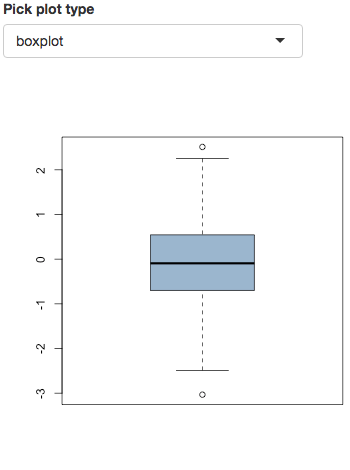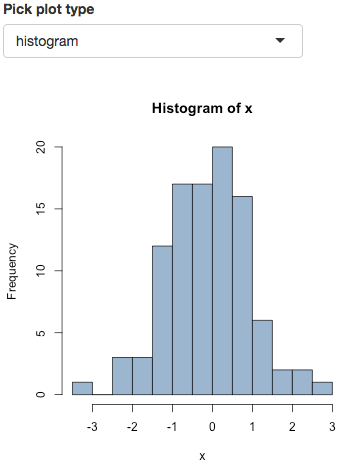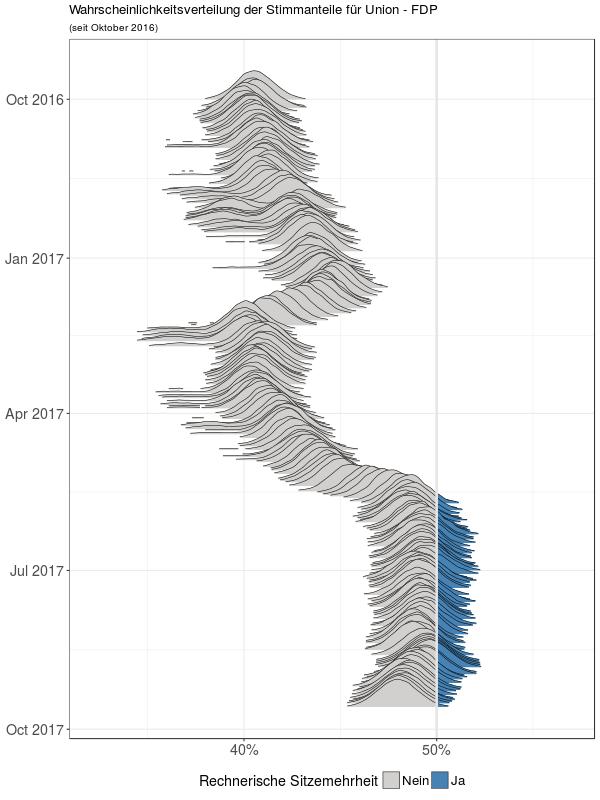Coalition analysis (KOALA) 2017
German election coalition probabilities
Alexander Bauer | Andreas Bender
StaBLab, LMU München
2017/09/20
Outline
- Motivation
Outline
Motivation
Implementation (Backend)
Outline
Motivation
Implementation (Backend)
Implementation (Frontend)
Outline
Motivation
Implementation (Backend)
Implementation (Frontend)
Outlook & sources
Motivation
When covering the election, media outlets (TV and print) mostly focus on questions like
Which parties will pass the 5% threshold and enter the "Bundestag" (German parliament)?
and
Which parties will form the governing coalition (currently Union - SPD, so called grand coalition)?
For the 2017 election also of special interest
Which party will have the 3rd largest share of votes?
Motivation
To answer these questions, pundits and writers usually focus on raw voting intention polls:
"Which party would you vote for if election was today?"
| Union | SPD | Greens | FDP | The Left | Pirates | AfD | Others |
|---|---|---|---|---|---|---|---|
| 40% | 26% | 10% | 5% | 9% | 2% | 4% | 4% |
Motivation
Interpretation of raw polls is problematic for several reasons
Sample uncertainty is ignored (even if the sample is representative, we would expect individual polls to deviate from the true shares).
- Exhibit 1.a: pollytix - Koalitionsrechner
- Exhibit 1.b: Tagesschau
Redistribution of votes is ignored (all votes for parties that do not pass the 5% threshold are redistributed proportionally to parties that pass the threshold).
- Exhibit 2: FAZ
Overreaction to individual polls (Some polls can be "off" or only depict the voting intention in a very short time-period; different weighting methods used by different pollsters)
- see Exhibits 1.b and 2
Example: BTW13
| Union | SPD | Greens | FDP | The Left | Pirates | AfD | Others |
|---|---|---|---|---|---|---|---|
| 40% | 26% | 10% | 5% | 9% | 2% | 4% | 4% |

Example: BTW13
Taking this poll at face value, 10% of votes would be redistributed:
| Union | SPD | Greens | FDP | The Left |
|---|---|---|---|---|
| 44.44% | 28.89% | 11.11% | 5.56% | 10% |

Example: BTW13
- This still ignores the sample uncertainty
- Therefore, we sample election outcomes from the Dirichlet distribution
forsa_13$percentround(gtools::rdirichlet(3, 1995*forsa_13$percent+0.5), 4)## [,1] [,2] [,3] [,4] [,5] [,6] [,7] [,8]## [1,] 0.4022 0.2634 0.1014 0.0439 0.0894 0.0157 0.0425 0.0414## [2,] 0.4206 0.2526 0.0915 0.0446 0.0949 0.0210 0.0336 0.0413## [3,] 0.4152 0.2629 0.0965 0.0518 0.0872 0.0154 0.0356 0.0353round(gtools::rdirichlet(3, 20*forsa_13$percent+0.5), 4)## [,1] [,2] [,3] [,4] [,5] [,6] [,7] [,8]## [1,] 0.4861 0.2415 0.0551 0.0123 0.0663 0.0148 0.0969 0.0270## [2,] 0.2443 0.1557 0.2510 0.1100 0.0548 0.0205 0.0898 0.0738## [3,] 0.4347 0.2295 0.0750 0.1335 0.0505 0.0016 0.0732 0.0021Example: BTW13
- Based on a simulation with
n=10000, FDP would not pass the 5% threshold in 50% of the cases - This leads to a bimodal distribution (after redistribution)

Example: BTW13
- Coalition probabilities can be obtained by calculating the area underneath
the probability distribution for
x>50 - Or simpler:
P(event|sample)=#simulations with event#simulations

KOALA: Coalitions Analysis
In our approach we
aggregate polls from different pollsters within a 14-day time-window (pooled survey)
Calculate the Posterior Dirichlet distribution (based on Multinomial Likelihood and flat/uninformative Dirichlet Prior)
Calculate "secondary" properties (e.g. probability that Union-FDP would have simple majority) via Monte-Carlo sampling
Simulate election outcomes from known Posterior (based on current pooled survey)
P(event|sample)=#eventnumber of simulations
Implementation (Backend)
Backend implemented in the R-package
coalitions(see Workflow vignette)scrapes wahlrecht.de for (new) polls
(calculates pooled sample)
calculate and sample from Posteriori
Redistribute votes below 5% threshold and calculate Seats based on method by Sainte-Lague-Scheppers (German Law)
Calculate coalition probabilities
Implementation (Backend)
- Install via
devtools::install_github("adibender/coalitions")- Surveys returned as nested tidy data set (
tibble)
surveys <- get_surveys()surveys## # A tibble: 7 x 2## pollster surveys ## <chr> <list> ## 1 allensbach <tibble [41 × 5]> ## 2 emnid <tibble [222 × 5]>## 3 forsa <tibble [231 × 5]>## 4 fgw <tibble [82 × 5]> ## 5 gms <tibble [96 × 5]> ## 6 infratest <tibble [107 × 5]>## 7 insa <tibble [301 × 5]>Implementation (Backend)
surveys %>% unnest() %>% select(-start, -end)## # A tibble: 1,080 x 4## pollster date respondents survey ## <chr> <date> <dbl> <list> ## 1 allensbach 2018-01-25 1221 <tibble [7 × 3]>## 2 allensbach 2017-12-21 1443 <tibble [7 × 3]>## 3 allensbach 2017-11-30 1299 <tibble [7 × 3]>## 4 allensbach 2017-10-25 1454 <tibble [7 × 3]>## 5 allensbach 2017-09-22 1074 <tibble [7 × 3]>## 6 allensbach 2017-09-19 1083 <tibble [7 × 3]>## 7 allensbach 2017-09-06 1043 <tibble [7 × 3]>## 8 allensbach 2017-08-22 1421 <tibble [7 × 3]>## 9 allensbach 2017-07-18 1403 <tibble [7 × 3]>## 10 allensbach 2017-06-20 1437 <tibble [7 × 3]>## # ... with 1,070 more rowsImplementation (Backend)
surveys %>% unnest() %>% slice(1) %>% unnest() %>% select(-start, -end)## # A tibble: 7 x 6## pollster date respondents party percent votes## <chr> <date> <dbl> <chr> <dbl> <dbl>## 1 allensbach 2018-01-25 1221 cdu 34.0 415 ## 2 allensbach 2018-01-25 1221 spd 21.0 256 ## 3 allensbach 2018-01-25 1221 greens 10.5 128 ## 4 allensbach 2018-01-25 1221 fdp 10.0 122 ## 5 allensbach 2018-01-25 1221 left 8.50 104 ## 6 allensbach 2018-01-25 1221 afd 12.0 147 ## 7 allensbach 2018-01-25 1221 others 4.00 48.8pooled survey
pooled_survey <- surveys %>% pool_surveys()pooled_survey %>% select(-start, -end)## # A tibble: 7 x 6## pollster date respondents party percent votes## <chr> <date> <dbl> <chr> <dbl> <dbl>## 1 pooled 2018-02-13 2533 afd 13.9 352## 2 pooled 2018-02-13 2533 cdu 31.4 796## 3 pooled 2018-02-13 2533 fdp 9.44 239## 4 pooled 2018-02-13 2533 greens 12.5 317## 5 pooled 2018-02-13 2533 left 10.5 266## 6 pooled 2018-02-13 2533 others 4.20 106## 7 pooled 2018-02-13 2533 spd 18.0 455Draw from Posterior
draws <- pooled_survey %>% draw_from_posterior(seed=123)draws[1:6, ]## # A tibble: 6 x 7## afd cdu fdp greens left others spd## <dbl> <dbl> <dbl> <dbl> <dbl> <dbl> <dbl>## 1 0.135 0.327 0.0841 0.126 0.116 0.0438 0.169## 2 0.125 0.323 0.0951 0.126 0.104 0.0392 0.188## 3 0.148 0.320 0.0934 0.126 0.101 0.0425 0.169## 4 0.133 0.307 0.0940 0.125 0.106 0.0462 0.189## 5 0.142 0.312 0.0957 0.116 0.103 0.0411 0.189## 6 0.132 0.322 0.0900 0.126 0.103 0.0423 0.184## calculate probabilities to pass 5% thresholddraws %>% summarize_all(funs(mean(.>0.05)))## # A tibble: 1 x 7## afd cdu fdp greens left others spd## <dbl> <dbl> <dbl> <dbl> <dbl> <dbl> <dbl>## 1 1.00 1.00 1.00 1.00 1.00 0.0274 1.00Redistribution and seats calculation
seats <- get_seats(draws, pooled_survey, distrib.fun=sls, hurdle=0.05)seats## # A tibble: 60,000 x 3## sim party seats## <int> <chr> <int>## 1 1 afd 84## 2 1 cdu 204## 3 1 fdp 53## 4 1 greens 79## 5 1 left 73## 6 1 spd 105## 7 2 afd 78## 8 2 cdu 201## 9 2 fdp 59## 10 2 greens 78## # ... with 59,990 more rowsCalculate coalition probabilities
probs <- seats %>% have_majority() %>% calculate_probs(coalitions=list(c("cdu", "fdp"), c("cdu", "fdp", "greens")))probs## # A tibble: 2 x 2## coalition probability## <chr> <dbl>## 1 cdu_fdp 0## 2 cdu_fdp_greens 100Wrapper
set.seed(123)pooled_survey %>% nest(party:votes, .key="survey") %>% get_probabilities(seed=123, nsim=1e4) %>% unnest()## # A tibble: 6 x 4## pollster date coalition probability## <chr> <date> <chr> <dbl>## 1 pooled 2018-02-13 cdu 0## 2 pooled 2018-02-13 cdu_fdp 0## 3 pooled 2018-02-13 cdu_fdp_greens 100## 4 pooled 2018-02-13 spd 0## 5 pooled 2018-02-13 left_spd 0## 6 pooled 2018-02-13 greens_left_spd 0Visualization
We visualize the posterior via "ridgeline plots" (formerly Joy plots)
Uses
ggplot,ggridges,gganimate- (click here for animated version; also featured at Spektrum.de)
Joy/Ridges-Plot (Implementation)
gg_distrb <- ggplot(schw_gelb, aes(x = percent, y = date2, group=date2, frame=date, cumulative=TRUE, fill=..x..>50)) + geom_density_ridges_gradient(scale = 10, size = 0.25) + geom_vline(xintercept = 50, lty=1, lwd=1.2, col="grey90") + scale_fill_manual( name = "Rechnerische Sitzemehrheit", breaks = c("FALSE", "TRUE"), labels = c("Nein", "Ja"), values = c("#d1d0ce", "steelblue") ) + theme(legend.position = "bottom") + scale_x_continuous(labels = function(x) paste0(x, "%")) + scale_y_continuous(trans = rev_date) + guides(fill=guide_legend(override.aes=list(alpha=1))) + theme( axis.text = element_text(size = rel(1.3)), axis.title.y = element_blank(), axis.title.x = element_blank(), legend.text = element_text(size = rel(1.2)), legend.title = element_text(size = rel(1.3))) + labs( title = "Wahrscheinlichkeitsverteilung der Stimmanteile für Union - FDP", subtitle = "(seit Oktober 2016)")Joy/Ridges-Plot (Implementation)
gg_distrb <- ggplot(schw_gelb, aes(x = percent, y = date, group=date, frame=date, cumulative=TRUE, fill=..x..>50)) + geom_density_ridges_gradient(scale = 10, size = 0.25) + # geom_vline(xintercept = 50, lty=1, lwd=1.2, col="grey90") + # scale_fill_manual( # name = "Rechnerische Sitzemehrheit", # breaks = c("FALSE", "TRUE"), # labels = c("Nein", "Ja"), # values = c("#d1d0ce", "steelblue") ) + # theme(legend.position = "bottom") + # scale_x_continuous(labels = function(x) paste0(x, "%")) + # scale_y_continuous(trans = rev_date) + # guides(fill=guide_legend(override.aes=list(alpha=1))) + # theme( # axis.text = element_text(size = rel(1.3)), # axis.title.y = element_blank(), # axis.title.x = element_blank(), # legend.text = element_text(size = rel(1.2)), # legend.title = element_text(size = rel(1.3))) + # labs( # title = "Wahrscheinlichkeitsverteilung der Stimmanteile für Union - FDP", # subtitle = "(seit Oktober 2016)")Animation
- If you're able to
ggplot, you are able togganimate! - The
gganimatepackage currently not on CRAN, install via:
devtools::install_github("drgtwo/gganimate")library(ggplot2)library(ggridges)library(gganimate)gg_distrb <- ggplot(schw_gelb, aes(x = percent, y = date, group=date, frame=date, cumulative=TRUE, fill=..x..>50)) + geom_density_ridges_gradient(scale = 10, size = 0.25)gganimate(gg_distrb, "output.gif", interval=.2, ani.width=600)- Set GIF parameters (width, height, etc. via
ani.options) - Control speed of the animation via
intervalargument
(lower values→higher speed) - Don't forget to set the
frameargument in the call toggplot(this is the variable over which the animation will iterate) - By setting
cumulative=TRUEcurrent frame also contains previous frames - Note:
alphaargument does not work with*_gradientgeoms
Frontend implementation
1) Creating a homepage with Shiny
2) Setting up the server with Shiny Server
3) APIs and stuff: tweetR and googlesheets
4) Keep the website running
Frontend - Shiny
Shiny in a nutshell:
R package by RStudio
Web application framework
Creation of interactive dashboards, running R in the background
Resources: Applied R Shiny Meetup, shiny.rstudio.com
Tip: Use shinydashboard for a more appealing dashboard UI
Frontend - Shiny
Shiny in a nutshell:
R package by RStudio
Web application framework
Creation of interactive dashboards, running R in the background
Resources: Applied R Shiny Meetup, shiny.rstudio.com
Tip: Use shinydashboard for a more appealing dashboard UI
Why Shiny?
Easy integration of interactive R output and calculations
No need for learning another language, Shiny creates the HTML, CSS and JavaScript for you!
Frontend - Shiny


Frontend - Shiny
library(shiny)ui <- fluidPage( selectInput("plotType_picker", "Pick plot type", choices = c("boxplot","histogram")), plotOutput("my_plot"))server <- function(input, output) { x <- rnorm(100) output$my_plot <- renderPlot({ if (input$plotType_picker == "boxplot") { boxplot(x) } else hist(x) })}shinyApp(ui = ui, server = server)Frontend - Shiny Server
Shiny Server in a nutshell:
Linux-based open source web server by RStudio
Access to the homepage starts an R process with a Shiny app on the server
Resources:
Frontend - Shiny Server
Setting up Shiny Server (on 64-bit Ubuntu 12.04+): (administrator's guide)
1) Install R and all needed R packages on the server
2) Install Shiny Server (install guide)
$ sudo apt-get install gdebi-core$ sudo wget https://download3.rstudio.org/ubuntu-12.04/x86_64/shiny-server-1.5.3.838-amd64.deb$ sudo gdebi shiny-server-1.5.3.838-amd64.deb3) Customize the shiny-server.conf file to your needs
- Tip 1:
'sanitize_errors false;'
gets you clearer error messages
'app_idle_timeout 0;'
saves startup time of the R process4) Put the Shiny files inside the path specified in shiny.server.conf
Frontend - Shiny Server
Capabilities of the free version (Shiny Server Open Source):
For non-commercial projects
Up to 20 users simultaneously
No multiple R processes!
→ code efficiently and precalculate results where possible
Frontend - Shiny Server
Capabilities of the free version (Shiny Server Open Source):
For non-commercial projects
Up to 20 users simultaneously
No multiple R processes!
→ code efficiently and precalculate results where possible
Shiny Server Pro: Commercial use, multiple R processes etc.
-
- Deploy Shiny apps on RStudio servers
- Free version limited to 25 hours of use per month!
Frontend - tweetR 
The tweetR package in a nutshell:
Our use case: Send tweets with new results
Resources: user vignette, tweetR on GitHub
Alternative (more modern) package: rtweet
Frontend - tweetR 
Sending a Tweet with tweetR:
1) Register a new Twitter app on apps.twitter.com
2) Use the credentials to do the authorization with R
setup_twitter_oauth(consumer_key = "your_consumer_key", consumer_secret = "your_consumer_secret", access_token = "your_access_token", access_secret = "your_access_secret")3) Start tweeting!
tweet(message = "Tweet tweet", mediaPath = "my_picture.png")Frontend - googlesheets 
The googlesheets package in a nutshell:
Our use case: Offering an API for our results
Resources: googlesheets on GitHub
Frontend - googlesheets 
Exporting a table to Google Sheets with googlesheets:
1) Extract your credentials:
auth_info <- gs_auth()saveRDS(auth_info, file = "auth_info.rds")2) Use the credentials to do the authorization with R
gs_auth(token = "auth_info.rds")3) Start uploading!
my_table <- data.frame("person" = c("Sepp","Uli","Franz"), "likes_koala" = c("yes", "yes", "yes"))write.csv(my_table, file = "my_table.csv")gs_upload("my_table.csv", sheet_title = "my_googleSheet", overwrite = TRUE)Frontend - Keep the website running
Automation of the server:
We check hourly if new surveys are available and update the results
Implementation: see next slide
Tip: Automatic error notification using Pushbullet

Supports notifications to all major (Desktop and mobile) systems
R package: RPushbullet on GitHub
Implementation of the automation process
1) Set up the R script
while (1 < 2) { # do something eternally # Step 1: check for new surveys and perform calculations update_results() # Step 2: Update services with new results if (new_results) { # if new results are available send_tweet() export_googleSheets() # restart the server to fetch the new results (on Ubuntu 15.04+) system("sudo systemctl restart shiny-server") } # Step 3: Rest for an hour Sys.sleep(60*10)}2) Start the R script on the server
R CMD BATCH update_results_everyHour.R &Outlook & sources
1) Future plans
2) Sources
Outlook - Future plans
Make frontend R package (shiny app) open source
Simplify data handling, Create online data base (with API), etc.
Extend the framework to:
- other elections (regional and international)
- improve interactive experience
- make @tagesschau (and others) use our methods!
Sources
General sources:
Raw voting intention polls: www.wahlrecht.de
Our slides are powered by Xaringan
tidyverse (previously hadleyverse)
Sources
General sources:
Raw voting intention polls: www.wahlrecht.de
Our slides are powered by Xaringan
tidyverse (previously hadleyverse)
How to reach us?
- Visit us on koala.stat.uni-muenchen.de
Contact us directly: koala@stat.uni-muenchen.de
Feel free to contribute on GitHub
Preparing for election day
Keep in mind:
We do not make predictions!
Many voters (~40%) still undecided
Preparing for election day
Keep in mind:
We do not make predictions!
Many voters (~40%) still undecided
So, stay tuned...
... and follow us on Twitter :-)
